Growing and caring for eggplants in greenhouse conditions
For a long time, many tropical vegetables were harvested only in hot countries. However, with the advent of polycarbonate greenhouses, growing eggplants in a greenhouse became possible even in the Urals!
Greenhouse
Before starting a conversation directly about growing eggplants and caring for them, you need to figure out - what is a polycarbonate greenhouse, why it is so good, what are its advantages over glass or polyethylene greenhouses, and why it is worth planting and growing tropical crops in it.
The standard materials have some disadvantages.
- The film transmits very little light; glass has very poor thermal insulation.
- Glass is quite fragile and breaks easily. The film requires replacement every two years, while it also has to be repaired several times over the summer until it finally becomes unusable.
- Every spring, the polyethylene has to be re-stretched over the greenhouse, and every autumn - removed, which takes a lot of time and effort.
A polycarbonate greenhouse is devoid of these drawbacks. This material is durable, lightweight and flexible. It perfectly transmits sunlight, but at the same time protects plants from excessive exposure to ultraviolet radiation. In such a greenhouse, it will be easy to maintain the required temperature, which is especially important for caring for eggplants.
Variety selection
When breeding eggplants in cold climates, it is extremely important to choose the right variety. The following will work:
- Dwarf early;
- Early maturing;
- Czech early;
- Quartet;
- Delicacy;
- Diamond;
- Donetsk fruitful;
- Czech handsome.
All of them are united by early maturation. If the planting takes place in the Urals, at least one hundred and twenty days should pass from the moment the fruit is formed to its readiness for collection. In more favorable areas, this period may be twenty days longer, but it is still better not to risk it.
Soil preparation
So, the greenhouse has been installed, the eggplant variety has been selected - now it is necessary to take care directly of the land in which the vegetables will grow. In the Urals and in other places where the soil itself is not very fertile, special attention should be paid to this. It is necessary to start training in the fall.
First of all, it is necessary to remove the remnants of what grew in this place before. Then water the planting site twice with water, thereby clearing it of the remnants of previous fertilizers. The next stage is disinfection so that no diseases and pests remain in the ground. As a rule, a solution of copper sulfate is used for these purposes.
Next, the soil should be dug up, or at least thoroughly loosened, and then start feeding. Organic fertilizers such as manure or compost work well for growing eggplants in a polycarbonate greenhouse. You can also add dolomite flour to them. It reduces the acidity of the soil and contains magnesium, which has a beneficial effect on the growth and development of vegetables.
It is also helpful to add some peat, ash and potassium sulfate to the ground.
Landing
Planting is carried out in spring, when the ground temperature is at least fifteen degrees, and the air temperature is eighteen. To do this, you need to make holes in the ground about fifteen centimeters deep, into which the sprouts will be buried. A handful of ash can be added to each planting hole.
Advice
You can buy ready-made eggplant seedlings, or you can remove them from the seeds yourself using peat pots. Unlike the standard method with wooden boxes, such containers can be buried in the garden along with the plants, without risking damage to the roots when removed.
The planting scheme is quite simple, but it must be borne in mind that the bushes of these plants are lush and spreading. This means that they need to be planted at a fairly large distance from each other - at least forty-five centimeters. It is desirable in one line, but it is also possible in a checkerboard pattern. In this case, the distance between plants increases to sixty centimeters.
After planting, watering is carried out with water, or better - with a solution of potassium permanganate. This provides additional protection against various diseases. The use of such an additional measure in the Urals, as well as in other places with a cold climate, will be especially relevant.
Care
Caring for eggplant in a polycarbonate greenhouse has some peculiarities. This is due to the fact that this plant is tropical, thermophilic. Competent agricultural technology is very important when growing. It is necessary to precisely observe the humidity and temperature regimes, to apply top dressing in a timely manner, to properly combat pests and diseases.
- Temperature regime
The temperature in the greenhouse must be maintained at twenty-six to twenty-eight degrees. It is important to remember that if the thermometer rises above thirty-five degrees, this is just as detrimental to eggplants as low temperatures.
Therefore, on especially hot days, you should ventilate the greenhouse by opening vents or windows on one side - to avoid drafts. We must also not forget that everything should be tightly closed at night, regardless of the weather outside.
With especially hot air outside, in addition to airing, it is recommended to water the plantings with cool water in order to cool the soil.
- Watering
The peculiarities of watering eggplants are that the soil moisture should be high, but the air, on the contrary, should be low. Do not allow moisture to enter the leaves of the plant. Watering is carried out strictly at the root, with warm water, the temperature of which is about twenty-five degrees.
It is also recommended to use a dry irrigation scheme. Its essence lies in the fact that 11-12 hours after watering, the soil is slightly loosened. This reduces the evaporation of moisture, leaving it in the soil.
The frequency of watering is about once a week before the start of fruiting and two after. In this case, the first time it is necessary to do this five to six days after planting.
- Fertilizer
In the Urals, where soil fertility is low, conditions are cold and harsh, and plants are constantly attacking diseases, proper eggplant care is especially important, in particular, soil fertilization.
You will have to feed it quite often in one summer - about five times. In this case, eggplants also have their own characteristics, one of which is the need to alternate mineral and organic fertilizers. This is due to the fact that organic matter has a better effect on fruiting, and mineral supplements - on the growth and general condition of the plant.
The first feeding is done two to three weeks after planting. Before fruit formation, the soil is fertilized with complex mineral additives. When the first ovary appears, it is worth feeding with nitrogen-phosphorus fertilizer. For strong, overgrown bushes, potassium is used, and for weak and stunted bushes, more nitrogen is required. All this alternates with organic supplements.
Advice
Mineral fertilizers can be given foliarly by spraying the leaves with an appropriate solution about twice a month. In this case, root feeding with organic matter is required.
- Garter and bush pruning
Eggplant pickling is not necessary. The only thing that will need to be removed is spoiled fruits and yellow leaves. Towards the end of summer, you need to pinch the tops of the shoots, and also remove the resulting flowers and ovaries, since the new fruits simply do not have time to ripen before the cold weather.
With proper care, the bushes grow quite tall, so you will have to tie them up.In particular, fasten to the trellis, but very carefully - the stems are fragile and can easily break.
Diseases and pests
An integral part of caring for any plant is the fight against diseases and pests. But to lead it, you need to "know the enemy by sight." Here is a list of the most common problems of this kind that can be encountered in the process of growing eggplant.
- Blackleg. The causative agent of this disease is a fungus. It appears as a darkening at the base of the ovary. If found, the affected plant is destroyed, and all the soil in the greenhouse is treated with a solution of bleach.
- Late blight. Also fungal disease. Symptoms - "rusty" spots on the leaves, whitening on the back of the leaf, rotting. Treatment is carried out by treating diseased parts of the plant with a solution of copper sulfate. Severely damaged leaves are removed from the bush and burned.
- Mosaic - a viral disease. Outwardly, it looks like light or dark green spots on the leaves. The latter are often deformed during the course of the disease. The only method of dealing with the manifestation of mosaic on adult plants is to remove and destroy damaged bushes.
Output
Growing eggplants in a greenhouse has its own characteristics. To obtain the best result, the planting scheme, temperature and humidity regime, and fertilization frequency must be strictly observed. Also, soil preparation, selection of varieties, timely elimination of diseases and pests play an important role in agricultural technology. Grazing is not required, but a garter of plants is necessary.
Care and cultivation is best done in a polycarbonate greenhouse. Growing in conventional film or glass greenhouses will be less efficient.

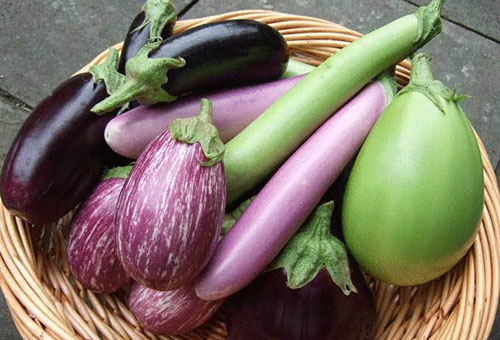
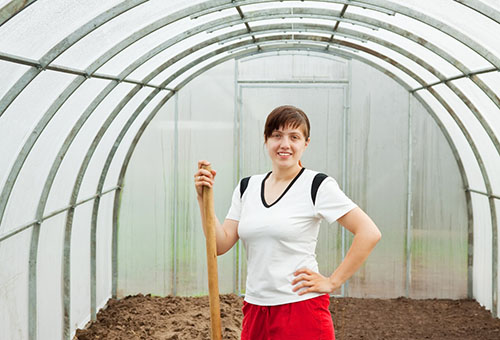
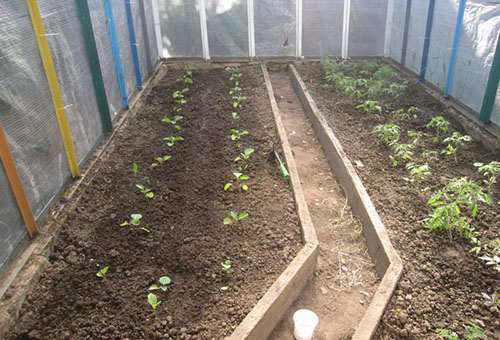
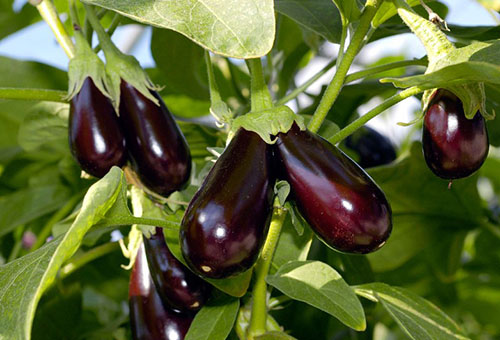
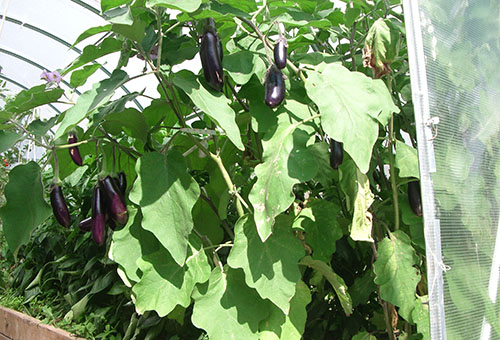
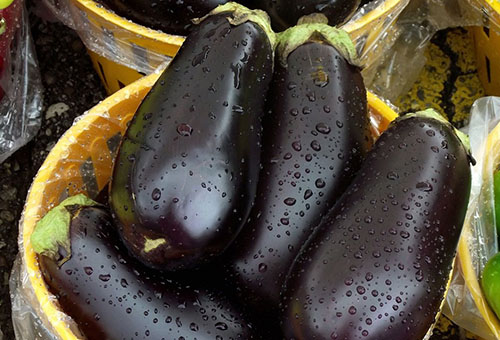

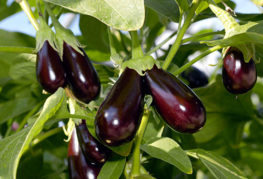


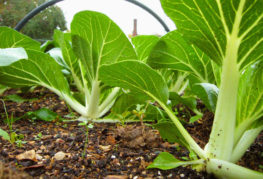
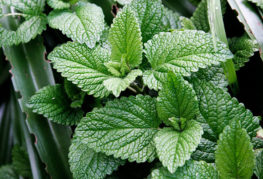
and will be published shortly.